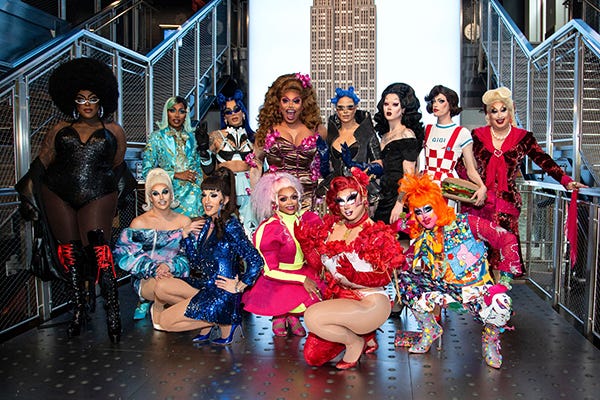Voguing to Victory: How Drag Ball Culture Shaped Pop Culture
The ways drag balls have influenced mainstream art and language
During Pride Month, we celebrate a community that is still marginalized in our society today, despite the fact that the start of what we now know as Pride–the Stonewall uprising–took place on June 28, 1969, over fifty years ago. When being gay was illegal, specific bars all over the country and in this case, New York City, were a haven for queer people–and they were often raided by police. One such morning, the Stonewall Inn in the West Village was raided without warning, resulting in a riot that would change the course of history and give birth to a civil rights movement. On the front lines was Marsha P. Johnson, a transgender woman and drag queen who led a series of protests after the riots.
The first Gay Pride Parade took place on the one year anniversary of the Stonewall raid in 1970. And the community never forgot that it was a drag artist that put herself on the line for them.
While the LGBTQ+ community faces–every day–direct attacks on their identities, legislation that hinders their rights, and misunderstandings in general, so much of mainstream culture has come directly from the queer community–specifically the drag community–over the decades. Often a popular song, movie or TV show breaks through, bringing with it slang or another element of culture with it, and many times the mainstream culture doesn’t even realize the origin of a particular colloquial saying or idea.
There are several books and countless articles written about the cultural impact of the highly successful and long-running TV show, RuPaul’s Drag Race, where drag queens compete in a combination fashion and lip sync competition for glory, bragging rights, and a nice amount of prize money. But Drag Race didn’t come out of nowhere, not by a long shot. It is a televised, somewhat sanitized, packaging of drag ball culture.
Drag ball culture has been around for decades–scratch that: over a century. The first drag ball on record can be traced back to 1869 in New York City and it was a national phenomenon. Over the decades, drag “houses” developed in many cities across the United States where “mothers” would teach their drag “children” about the art of performing and generally take them under their wings. These houses became families, safe havens for the marginalized, and in the 20th century, houses would compete against each other, and queens from all different categories would come together to perform, lip sync, etc.
Today, there are many drag houses and families, and every drag house has its own specific identity based on common interests, race, political activism, etc. They are artist collectives that often participate in other art forms in addition to drag as well as advocacy. And many representatives of these houses have, yes, competed on Drag Race, bringing this largely underground culture to the masses on an internationally successful TV show.
Of course Drag Race wasn’t the first piece of mainstream culture to borrow from ball culture: Madonna’s “Vogue,” the 1990 song and music video, directly referenced it (to the chagrin of some). “Vogue” is undeniably one of her biggest hits of all time, played everywhere from big cities to the smallest towns where there likely is no resident ball culture. Madonna was influenced by the House of Xtravaganza in New York City, and brought what she saw there to the music video for the song, directed by David Fincher. The voguing in the video was choreographed by Jose Gutierez Xtravaganza and Louis Camacho of the House of Xtravaganza. The video is all around a celebration of queer culture; in it you can also see the paintings of Tamara de Lempicka, a bisexual Polish art deco artist from the early 20th century, whose work Madonna is a huge fan and collector of. (Her paintings have been featured in several Madonna videos and on her most recent concert tour.)
Everyone knows what it means to “vogue” thanks to Madonna making the term ubiquitous over thirty years ago. We use all sorts of slang in everyday language around the world that comes from drag culture–especially as mainstream queer culture is topping the podcast charts, music charts, and more.
There are countless terms we use in mainstream language that come from drag culture, and RuPaul herself had a hit with the song “Supermodel (You Better Work)” in 1992. This was a direct draw from runway ball culture, and the phrase “you better work” or “work it” is universally recognized as an encouragement to tackle anything you want to with confidence and style.
It is likely because of the way ball culture has hit the mainstream through Drag Race, but surely you’ve heard–or said–the terms “Yasss kween!” or “slay.” Both can be found on many a t-shirt in your local department store and heard amongst the moms at a small town dance recital, but it’s important to know where these terms came from: 1980s drag balls. “Yass kween” can be heard in the 1990 documentary, Paris is Burning, the most popular major documentary about drag ball culture and its history and impact.
Slang like “throwing shade” and “spilling the tea” are very much part of our lexicon and come from drag culture, specifically amongst non-white drag queens of color: to openly insult someone is to “throw shade,” and “spilling tea” is to share scandalous information, drawing from the American southern tradition of women having tea parties to gossip. This subversion of meaning, using a phrase that directly references a space gay men of color would never be allowed to be in, is a hallmark of the slang that prevails within the drag culture.
We’ve all heard a Taylor Swift fan call her “mother” at least once, evoking the “mother” figures that give marginalized individuals a place to belong within drag houses. Whether Taylor qualifies as a “mother” in that sense is up to the individual fan, but it is interesting that one of Taylor Swift’s Eras Tour dancers, Kameron Saunders, has a 16-count solo during “Bejeweled” in which he improvises a ball-culture-inspired dance on every night of the tour. It doesn’t get more mainstream than the massive Eras Tour.
And ball culture continues to go mainstream. In 2024, Andrew Lloyd Weber’s Cats–the massively successful musical (turned into the movie which nobody speaks about) is getting a complete reimagining at New York City’s brand new Perelman Performing Arts Center near the site of the 9/11 Memorial. Cats: The Jellicle Ball is staged as an immersive competitive drag ball. This is a direct response to the pervasiveness of a show like Drag Race to bring ball culture to a mainstream audience and a theater community that celebrates innovation–the reviews are spectacular, the tickets are selling out, and the buzz is off the charts. This video of the cast rehearsal went viral:
There are so many other ways drag culture has influenced the mainstream, from drag brunches to all-ages drag story hours and more. While drag culture is still, currently, facing resistance at the community and legislative level in many places, it has always been an art form that is one of persistence, striving for acceptance, individuality and freedom of expression, which is what Pride Month is all about.
Want more? Head over to our Discord where you’ll find tons of other fans there chatting in our forums about the books, TV shows, movies, music, and games we all love! Don’t forget to follow us on Instagram, tumblr, and Spotify for more fandom content—and hit that subscribe button so you never miss a thing at rmrk*st!






